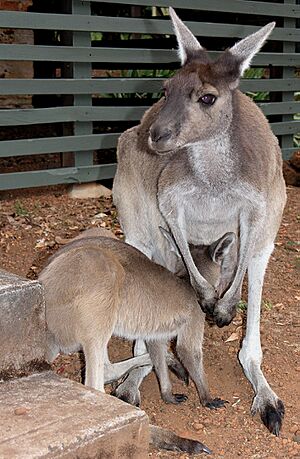Western grey kangaroo facts for kids
Quick facts for kids Western grey kangaroo |
|
|---|---|
 |
|
| Wild western grey at sunset, Western Australia | |
| Conservation status | |
| Scientific classification | |
| Genus: |
Macropus
|
| Species: |
fuliginosus
|
 |
|
| Western grey kangaroo range | |
The western grey kangaroo (Macropus fuliginosus) is a very large and common type of kangaroo. You can find them all across the southern parts of Australia. They live from Shark Bay in Western Australia all the way to western Victoria. They also live along the coast in South Australia and in the Murray-Darling Basin in New South Wales and Queensland. The subspecies living on Kangaroo Island, South Australia, is known as the Kangaroo Island kangaroo.
Contents
Meet the Western Grey Kangaroo
The western grey kangaroo is one of the biggest kangaroos around. It can weigh between 28 and 54 kilograms. Its body is about 0.84 to 1.1 meters long, with a tail that adds another 80 to 100 centimeters. These kangaroos can stand about 1.3 meters tall.
Male kangaroos are usually much bigger than females, sometimes even twice their size! This difference between males and females is called sexual dimorphism. They have thick, rough fur that can be pale grey or brown. Their throat, chest, and belly are usually lighter in color.
Western grey kangaroos eat mostly at night. Their diet includes grasses, leafy shrubs, and small trees. Older male kangaroos sometimes have a strong, curry-like smell. Because of this, they are sometimes called "Stinkers"!
Social Life and Reproduction
Western grey kangaroos live in groups of up to 15 animals. During the breeding season, males will compete for females. They have "boxing" contests where they lock arms and try to push each other over. Usually, only the strongest male in the group gets to mate.
A baby kangaroo, called a joey, grows inside its mother for about 30 to 31 days. When it's born, the tiny joey crawls into its mother's pouch. It attaches to a teat inside the pouch and stays there for about nine months. Even after it leaves the pouch, the joey will continue to drink milk from its mother for another nine months or so.
How Scientists Classified This Kangaroo
Aboriginal people in Australia have known about the western grey kangaroo for a very long time. For Europeans, understanding this kangaroo was a bit confusing for almost 200 years!
The first time European settlers saw them was in 1802. The explorer Matthew Flinders landed on Kangaroo Island and shot some for food. He thought they were the same as eastern grey kangaroos.
In 1803, French explorers captured some Kangaroo Island Western Greys. They took them back to Paris, France, where they lived in a zoo. Years later, in 1817, scientists at the Paris Museum of Natural History realized these animals were different. They officially named the species Macropus fuliginosus. But, for some reason, they mistakenly thought it was from Tasmania.
It took over 100 years for scientists to sort things out! By 1917, they realized the "forester kangaroo" in Tasmania was actually the eastern grey kangaroo (Macropus giganteus). Then, by 1971, they understood that the Kangaroo Island kangaroos were the same as those found in southern Western Australia. This population also stretched across much of eastern Australia.
For a while, scientists thought there were three different types, or subspecies, of western grey kangaroos. But by the early 1990s, they finally understood the species as we know it today.
Types of Western Grey Kangaroos
There are two main types, or subspecies, of the western grey kangaroo:
- Macropus fuliginosus fuliginosus: This subspecies lives only on Kangaroo Island.
- Macropus fuliginosus melanops: This subspecies is found across the mainland, with slight differences in appearance from west to east.
The western grey kangaroo does not live in the tropical northern parts of Australia or the very fertile south-east. The eastern grey kangaroo does not live past the New South Wales-South Australia border. However, both species are common in the Murray-Darling Basin area. They do not breed with each other in the wild. But, in zoos, eastern grey females and western grey males have had babies together.
The western grey kangaroo is also known by other names, like the black-faced kangaroo, mallee kangaroo, sooty kangaroo, and carno kangaroo.
Images for kids
-
A family of Kangaroo Island western grey kangaroos (Macropus fuliginosus fuliginosus) in springtime, Flinders Chase National Park, Kangaroo Island, South Australia
-
A close-up at Serpentine Falls National Park in Western Australia
-
A young kangaroo grazing near Mundaring Weir
See also
 In Spanish: Canguro gris occidental para niños
In Spanish: Canguro gris occidental para niños






